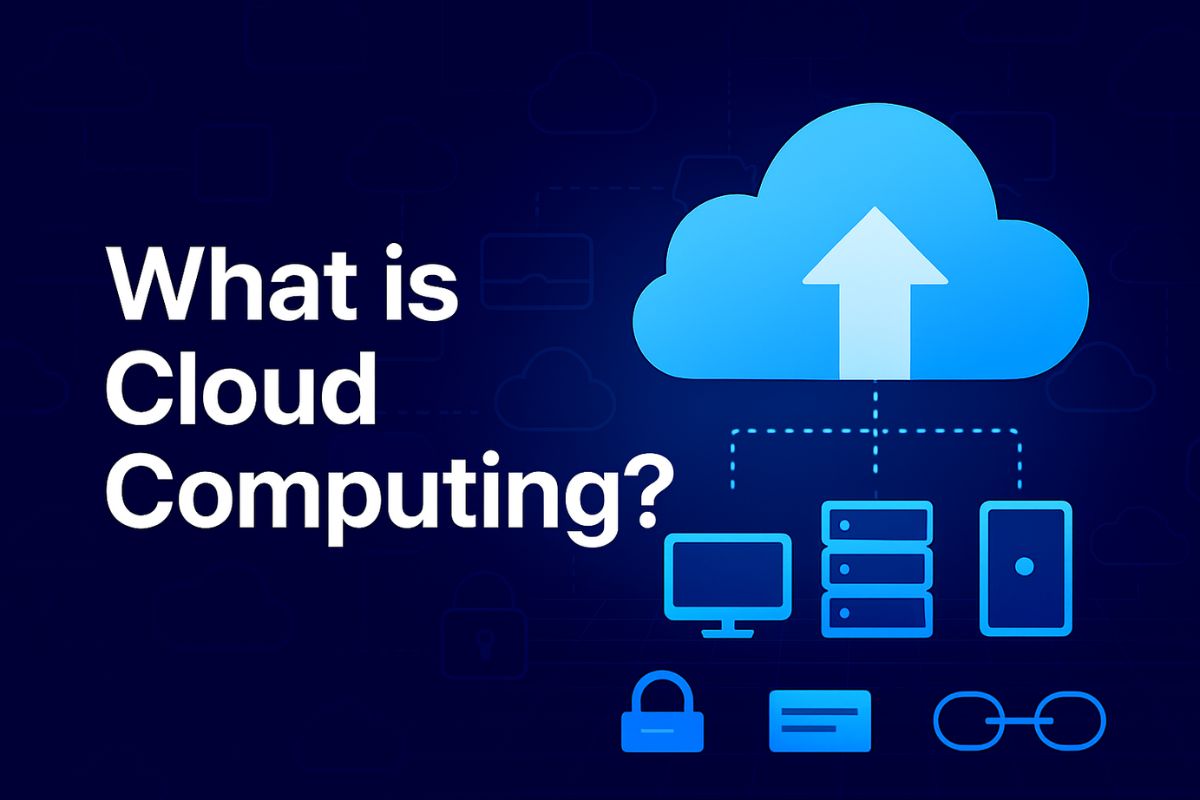Cloud computing is the delivery of IT services—like servers, storage, software, and databases—over the internet (“the cloud”) to offer faster innovation, flexible resources, and cost savings. This blog explains the types of cloud models, how it works, its benefits, real-world examples, and career opportunities in India and globally.
Have you ever uploaded a photo to Google Drive, streamed a movie on Netflix, or joined a Zoom call? Then you’ve already used cloud computing—possibly without realizing it.
Cloud computing is not just a tech buzzword. It’s the backbone of digital transformation in industries across India and the globe. From startups to government programs like DigiLocker and eSanjeevani, cloud computing is everywhere.
In this beginner’s guide, we’ll explain cloud computing in simple terms, explore its types, real-life uses, pros and cons, and how you can start a high-paying cloud career in 2025.
What is Cloud Computing?
Cloud computing is the on-demand delivery of computing services—like servers, storage, databases, networking, software, and analytics—over the internet (“the cloud”) with pay-as-you-go pricing.
Instead of buying hardware or managing servers yourself, you rent what you need from cloud providers like AWS, Microsoft Azure, or Google Cloud.
Think of it as using electricity—you don’t generate it; you just plug in and use what you need.
How Cloud Computing Works
- Cloud providers run massive data centers across the world.
- Users access these resources using the internet.
- You only pay for what you use.
- Services are auto-scalable and managed remotely.
For example, hosting a website using AWS EC2 lets you skip buying expensive servers or worrying about maintenance.
Types of Cloud Services (Service Models)
| Model | What It Offers | Examples |
|---|---|---|
| IaaS (Infrastructure as a Service) | Virtual servers, storage, networking | AWS EC2, Google Compute Engine |
| PaaS (Platform as a Service) | Development tools, runtime environment | Heroku, Google App Engine |
| SaaS (Software as a Service) | Complete apps accessed via browser | Gmail, Zoom, Canva |
Cloud Deployment Models
| Model | Description | Use Cases |
|---|---|---|
| Public Cloud | Shared resources; most common | Startups, E-commerce |
| Private Cloud | Dedicated to one organization | Banks, Gov. agencies |
| Hybrid Cloud | Combines public + private | Healthcare, MNCs |
| Community Cloud | Shared by similar groups | Universities, NGOs |
Benefits of Cloud Computing
Global Benefits
- Cost-Effective: No capital investment in infrastructure.
- Scalable: Easily increase/decrease usage as needed.
- Reliable: Automatic backups and disaster recovery.
- Accessible: Use from anywhere with internet access.
- Environmentally Friendly: More efficient energy usage.
India-Specific Benefits
- MSMEs and startups get global-scale infrastructure affordably.
- Government schemes like DigiLocker, eSanjeevani, and BHIM UPI rely on the cloud.
- Telecom giants like Airtel and Jio are launching cloud services for schools and SMBs.
Real-World Applications of Cloud Computing
Global Examples
- Netflix uses AWS to stream to millions.
- Uber uses Google Cloud for ride-matching and tracking.
- NASA uses cloud for satellite data and simulations.
Indian Examples
- DigiLocker stores academic and legal documents online.
- eSanjeevani powers remote medical consultations.
- Aadhaar’s biometric system uses cloud architecture.
- BYJU’S and Vedantu deliver classes via the cloud.
Cloud Computing vs Traditional Computing
| Feature | Traditional Computing | Cloud Computing |
|---|---|---|
| Cost | High upfront hardware | Pay-as-you-go |
| Setup Time | Weeks or months | Minutes |
| Maintenance | Manual | Automated by provider |
| Accessibility | On-site only | Anywhere via internet |
| Scalability | Limited and slow | Instant |
| Data Backup | Local, manual | Cloud-based, automated |
Leading Cloud Providers in 2025
| Provider | Strengths | Popular Services |
|---|---|---|
| AWS | Market leader, flexible | EC2, S3, Lambda |
| Microsoft Azure | Enterprise-grade security | Azure DevOps, ML Studio |
| Google Cloud | AI & Data tools | BigQuery, Vertex AI |
| IBM Cloud | Hybrid cloud expertise | Watson, Cloud Functions |
| Oracle Cloud | Enterprise SaaS, finance focus | Oracle ERP Cloud |
| Airtel Cloud | India-focused | Airtel IQ, B2B cloud |
| JioCloud | Affordable storage for India | JioMeet, JioWorkCloud |
How to Start Learning Cloud Computing
Step-by-Step Roadmap for Beginners
- Understand basic concepts (via this blog or YouTube)
- Choose a platform (AWS, GCP, or Azure)
- Use free tier accounts to practice
- Learn core services: compute, storage, networking
- Get certified (see below)
- Work on hands-on projects using GitHub/Kaggle
- Follow Indian case studies (Aadhaar, DigiLocker, etc.)
Best Online Learning Platforms
- AWS Academy – Cloud foundations, practitioner certification
- Google Cloud Skills Boost – Hands-on labs and courses
- Microsoft Learn – Beginner to expert Azure paths
- NPTEL – Cloud Computing course by IITs
- Simplilearn/Edureka – Industry-oriented training
- YouTube Channels – Apni Kaksha, CodeWithHarry, freeCodeCamp
Career Opportunities in Cloud Computing (India & Global)
Top Job Roles
- Cloud Engineer
- DevOps Engineer
- Cloud Solutions Architect
- Cloud Security Analyst
- Site Reliability Engineer (SRE)
Salaries (India & Global)
| Role | India Salary (₹/year) | Global Salary ($/year) |
|---|---|---|
| Cloud Engineer | ₹6–12 LPA | $100,000–130,000 |
| DevOps Engineer | ₹8–15 LPA | $110,000–140,000 |
| Cloud Architect | ₹12–20 LPA | $130,000–160,000 |
| Cloud Security Expert | ₹10–18 LPA | $120,000–150,000 |
Challenges in Cloud Computing
Global Challenges
- Data security risks
- Vendor lock-in
- Regulatory compliance (especially for healthcare & finance)
- Downtime dependency
India-Specific Issues
- Internet access in rural areas
- Data sovereignty – Indian user data stored abroad
- SME awareness still low in Tier-2, Tier-3 cities
Free Tools & Resources for Practice
| Tool | Purpose | Free? |
|---|---|---|
| AWS Free Tier | Cloud computing trial | Yes |
| Google Cloud Free | Hands-on labs + $300 credits | Yes |
| Microsoft Azure Learn | Tutorials + sandbox | Yes |
| Qwiklabs | Labs for GCP & AWS | Yes |
| GitHub | Share & learn projects | Yes |
FAQs
1. What is cloud computing in simple words?
It’s a way to use computing services like storage and software over the internet without owning the hardware.
2. What are the types of cloud services?
IaaS, PaaS, and SaaS—offering infrastructure, platforms, and software via cloud.
3. What are the benefits of cloud computing?
Low cost, easy access, scalability, automatic updates, and global reach.
4. What is the future of cloud computing in India?
With 5G and Digital India, cloud is expected to grow across education, banking, agriculture, and healthcare sectors.
5. Can a student start a cloud career without a degree?
Yes! Many roles are skill-based. Certifications, projects, and GitHub portfolios matter more than degrees.
6. Which companies use cloud in India?
TCS, Infosys, Flipkart, BYJU’S, Zoho, Paytm, DigiLocker, and many startups.
7. What are the risks of cloud computing?
Security breaches, vendor lock-in, and internet outages are the key concerns.


